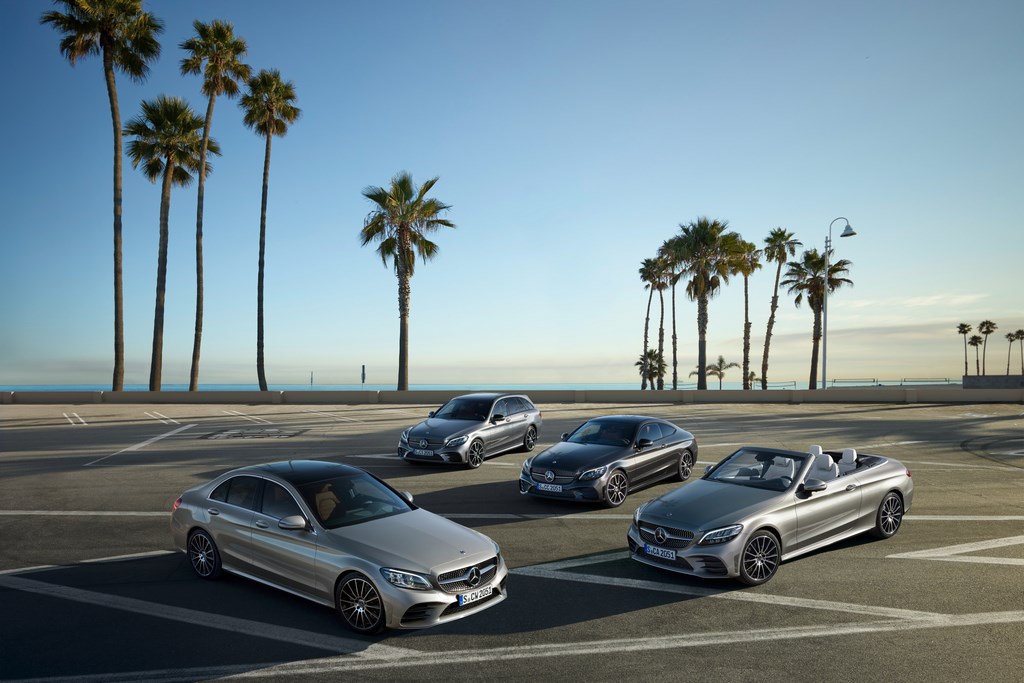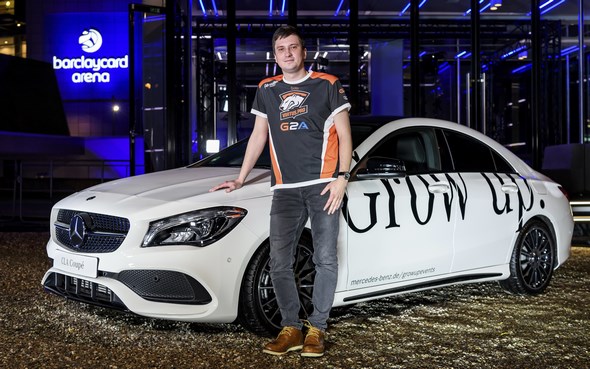Modern classics: the S-Class Saloons of the Mercedes-Benz 140 series (1991 to 1998)
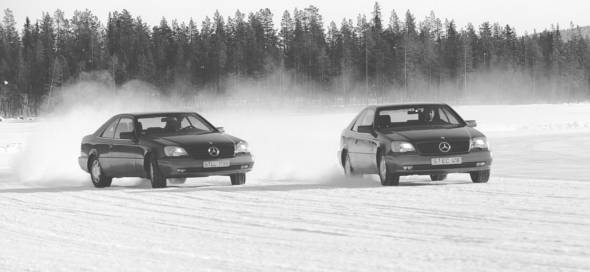

- Peak of perfection in automobile manufacture
- Widely held view: “The best car in the world”
- Bedded in the extraordinary tradition of the brand’s luxury-class vehicles
Stuttgart – The 140 series S-Class Saloons gave a clear message when they were introduced in 1991: their size and design lent them an imposing appearance, combined with highest comfort and lavish interior spaciousness.
Certainly these attributes are appropriate to a Mercedes-Benz S-Class.

And yet this model series was anything but undisputed when it came out: critics complained it had turned out too big, which brought disadvantages in everyday use, and on top of that was out of step with the times.
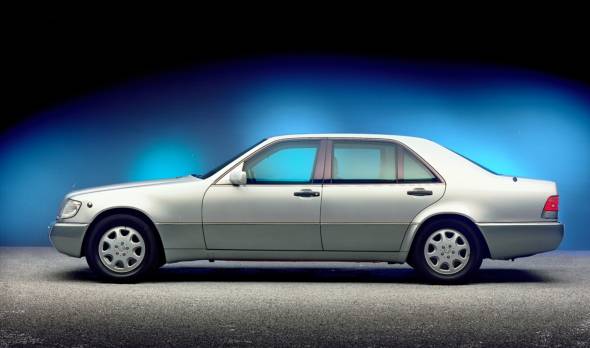
Such opinions were voiced mainly in Europe. In the USA or in Asia, for example, many customers took exactly the opposite view.
For them, the 140 series was an S-Class in exactly the right format – precisely because of its impressive appearance, which to them was simply befitting of a vehicle in which the world’s successful, wealthy and political leaders could either drive themselves or be driven.

This divergence of opinions was to accompany the saloons of the 140 model series from that point on, and the successor series launched in 1998, the 220, turned out rather more discreet.
Nevertheless, the 140 series received a great deal of praise from all sides. In 1991, for example, the trade magazine Auto, Motor und Sport, Germany, went as far as to write: “It would not be wrong here to describe this as the world’s finest car – any less would be to do Mercedes an injustice.”

The world’s finest car – that is quite a claim. But it is one Mercedes-Benz and its predecessor brands have been living up to since the beginnings of the automobile.

For the 140 series the engineers and designers addressed the task with the greatest dedication.
Leaving aside the sheer dimensions of the body, one has to give great credit to the stylists under the supervision of chief designer Bruno Sacco: what they drafted was a luxury-class saloon with clear lines that unmistakably established its connection with brand history, yet at the same time delivered a statement for the 1990s and were almost timeless in character.
Almost twenty years on, a 140 series S-Class is still an extremely handsome car.

The high standard applied to the vehicle was reflected in all details. For instance, the interior, so lavishly appointed, simultaneously demonstrated the restraint desired by the majority of S-Class customers.
Spaciousness and features made the time spent in a 140 series S-Class an absolute enjoyment.
That was also true of the driver’s seating position: perfectly equipped, it made even extremely long journeys exceedingly pleasurable.

The suspension also played a part in this. The engineers used all their resourcefulness and skill to design it: not only was travel in the saloon extremely safe on any road surface, it was also extremely comfortably.
In addition to excellent springing, the body was decoupled from audible and otherwise perceptible vibrations.
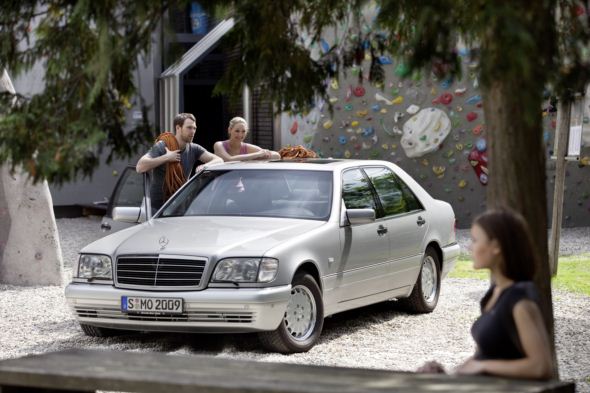
And although the 140 series S-Class was a big car, customers and motor journalists all over the world nevertheless praised it for its road manners – it was fleet-footed and able to negotiate even winding country roads impeccably at speed.

Typical of the great effort invested by Mercedes-Benz in this vehicle, for example, was the double insulated glazing, which benefited safety and comfort in several ways: avoidance of fogging (condensation) and icing, enhanced thermal insulation, enhanced insulation against external sources of noise, better flow of air around the vehicle and prevention of wind noises caused by window seals. Never before had car windows been so meticulously designed.

The high safety standard already attained in the previous series was clearly raised further by numerous measures.
For example, the body structure of the 140 series afforded still more protection in all types of accidents. A number of details – solutions designed to take the sharpness out of potential points of contact – served the protection of other road users as well.

The braking system was state-of-the-art, delivering optimum deceleration values.
From 1995 onwards the Electronic Stability Program ESP® was additionally available, initially for the eight-cylinder S-Class model and later for all models with automatic transmission.
In the S 600 it was standard equipment.

After December 1996 all models additionally featured the Brake Assist BAS, which optimally increased braking power under emergency braking and shortened the stopping distance.

As was customary in the S-Class, six- and eight-cylinder engines were available to power the car – from 1991 on there was even a twelve-cylinder power plant.
This unit epitomised the art of engine making, but the other units too enabled a mobility ideally suited to the Mercedes-Benz S-Class.
All were fitted as standard with an emission control system featuring a closed-loop catalytic converter, and consequently satisfied comprehensive environmental standards.

At the same time these engines were symbols of the longevity of the 140 series – they, and, of course, the entire vehicle, were designed for very high mileages and thus for years and years of use.
That made the 140 series S-Class well suited for use as a modern classic: anyone who buys one today, acquires a vehicle built to meet the highest requirements.
In that sense it is part of the remarkable tradition of the luxury-class saloons of the Mercedes-Benz brand, which together with its predecessor brands goes back to the beginnings of the automobile.

Mercedes-Benz’s excellent spare parts supply has helped maintain a modern classic: almost every part can be procured through a Mercedes-Benz dealer and the company’s own ordering system; delivery is usually made overnight.
Some authorised service shops have even been designated Classic Partners, possessing outstanding competence in handling older vehicles.
And particularly where young classics are concerned, all Mercedes-Benz company-owned sales and service outlets and partners boast the same high levels of expertise as ever.
Not for nothing does the slogan “Service for a lifetime” apply to all vehicles of the brand.
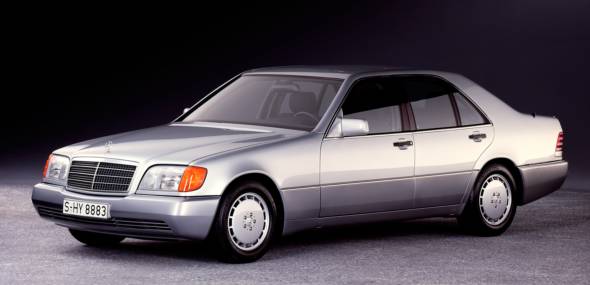
- Absolute perfection
- Impressive appearance and spaciousness in abundance
- First series-produced twelve-cylinder passenger car engine from Mercedes-Benz
In March 1991 a new model series of the S-Class (140 series) debuted at the Geneva Motor Show.
The body design took up the traditional, Mercedes-Benz-typical style elements and thus fit smoothly into the passenger car model family with its homogeneous design.
As was already the case with the SL models of the 129 series, the styling of the radiator grille of this S-Class, as characteristic mark of the brand, was reinterpreted, retaining the traditional basic form.

In this variation of a classic theme, called an “integrated radiator”, the radiator grille with its much narrower chrome frame was organically incorporated into the bonnet; for the first time the Mercedes star no longer sat on the grille, but on the bonnet, a little behind the grille.
All in all the design concept for this S-Class generation aimed at achieving a high level of aerodynamic quality while making allowance for maximum workaday suitability.
As with the predecessor models of the 126 series and generations of Mercedes-Benz premium-class series before them, the normal version was also accompanied by a long-wheelbase variant, in which the additional 100 millimetres served exclusively to increase legroom in the rear.

As far as the engine was concerned, initially four units were available on the domestic market, of which only the 5.0-liter V8 four-valve M 119 was an old and familiar friend.
As with the 500 E of the mid-range 124 series, the engine used here was the so-called Einheitsdeckmotor (standard engine) – a crankcase for both the 4.2 and 5.0-litre assemblies – whose fully-electronic Bosch “LH Jetronic” injection system was controlled via a hot-wire air mass sensor.

The other three engines were new developments: patterned after the 5.0-litre power plant, the 4.2-litre four-valve V8 was derived from the proven 4.2-litre two-valve unit, and the in-line six with 3.2 litres displacement was based on the 3.2-litre four-valve unit introduced two years earlier.
An interesting detail to note here is that the model designation of the 3.2-liter and 4.2-liter models did not reflect exactly the displacement as had always been the case in the past.
Instead, for the sake of homogeneity the designations 300 SE/SEL and 400 SE/SEL were chosen.

The twelve-cylinder
The 6.0-litre V12 engine M 120 was an entirely new design. Not only was it the first twelve-cylinder passenger car engine to be produced in series by Mercedes-Benz, its rated output of 300 kW also made it the most powerful Mercedes-Benz passenger engine at the time.
With rated torque of 580 Newton metres, it reached the 500 Newton metres mark at 1600 rpm. Like the six-cylinder and the two V8s, the twelve-cylinder also featured four valves per cylinder; its intake camshafts were adjustable with the car on the move, and it had the electronic injection system with hot-wire air mass sensor.

In all engines the emphasis was on minimising pollutant emissions and fuel consumption. The new fully electronic ignition computed the optimum ignition timing from a total of 300 ignition maps – for each cylinder individually and adapted to the knock limit.
The M 120 was the only twelve-cylinder in the world to have this cylinder-selective anti-knock control.
It alone enabled the high compression ratio of 10:1 needed for optimum fuel utilisation.


Also a completely new design was the engine management system, in which all control modules communicated with each other via a common data channel.
This enabled the control units to work in unison and was used among other things to quickly heat up the catalytic converters after a cold start, and also for the acceleration skid control ASR and the new engine friction torque control, which maintained handling stability during power-off situations on slippery road surfaces.

The V12 offered the largest catalytic converter system for passenger cars worldwide. It had a volume of seven litres so that the catalytic converter would not give rise to additional fuel consumption, and also to guarantee high long-term stability.
Thanks to a new concept employing double-walled exhaust manifolds with a triple layer of insulation, plus double-walled pipes, the ceramic catalysts embedded in heat-insulating expandable matting reached the optimum operating temperature in an extremely short time.

Environmental compatibility
In addition to optimizing and reducing exhaust emissions, the 140 model series also featured a number of other details that made it a pioneer for environmentally compatible automotive production.
It rang in the age of CFC-free (chlorofluorocarbon-free) automobiles and set trends in recycling.
The plastic components used were not only recyclable and clearly identifiable, in many cases they were already manufactured using recycled granulates.
In 1992 the 140 series received the US Environmental Protection Agency’s environment prize, the Stratospheric Ozone Protection Award.

Apart from the reduction of fuel consumption and the improvement of environmental compatibility, in the development of the 140 series particular emphasis was placed on the further perfecting of comfort and safety.
Along with many other factors, here the careful design and tuning of the suspension played a special role.
Functioning as front suspension was a newly developed double-wishbone front axle, mounted with its major points of load application on a front axle carrier so as to decouple the body from audible and otherwise perceptible vibrations.

The rear suspension was derived from the multi-link independent suspension units of the other car series; the wheel location was fundamentally revised and modified to meet the special requirements of the S-Class.
Making allowance for the appreciably higher longitudinal and lateral forces, the geometry of the links and struts was reconfigured.
Of particular interest was the crossed design of the upper links, which allowed bulk volume of the axle to be kept to a minimum in spite of the long control arms.

As regards active safety, the S-Class Saloons of the 140 series were distinguished by exceptionally good straight-line stability even on bumpy roads, low crosswind sensitivity, and precise steering; handling behaviour was largely insensitive to different load conditions.
The braking system of the eight- and twelve-cylinder models constituted a fundamental innovation.
It transferred more brake power to the rear wheels to enhance the fade resistance of the brake system and reduce front brake wear.

High degree of ride comfort
The ride comfort of the 140 series was appreciably improved once more. The tyre noise and vibrations transmitted to the passenger compartment were reduced to a large extent, the pitching motions during start-off and braking minimised; the rolling motions during cornering or on rough roads were reduced, and the steering was practically insensitive to bump steer.
In the eight- and twelve-cylinder variants a so-called parameter-controlled steering with speed-sensitive steering torque found use.
It reduced the steering effort to be applied by the driver during slow operation, for example when parking.

Safety had already been taken to high standards in the predecessor model series, but here numerous measures achieved further improvements.
The new body structure, for example, provided even more safety in all types of accidents.
And a series of small design appointments designed to reduce hazards from potential impact points also gave added protection to other road users.
In addition, double insulated glazing, used for the first time in a car series, went a long way to improving comfort.
It integrated a great many safety and comfort-related attributes: avoidance of fogging (condensation) and icing, enhanced thermal insulation, enhanced soundproofing against external sources of noise, improved external air flow and the elimination of wind noise caused by window seals.

Two further design details – folding exterior mirrors and extendable guide rods to help with reversing – gave drivers additional assistance when manoeuvring in small spaces with poor visibility.
To gain room for manoeuvring in cramped situations, the exterior mirrors could be folded to the rear by an electric motor controlled by means of a centrally-positioned switch on the centre console, the same switch serving also to angle the mirrors correctly.
To better estimate the distance from obstacles when reversing during manoeuvring, extendable markers or guide rods were built into the rear of the vehicle, in the left and right wings.
Two seconds after selecting reverse gear, the pneumatically operated 65-millimeter-long chrome rods automatically extended vertically, retracting again eight seconds after a new gear had been selected.
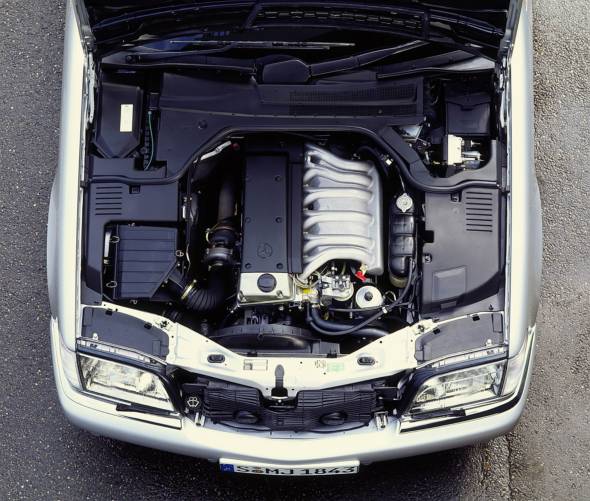
Diesel for Europe
In October 1992 the 300 SE 2.8 and 300 SD Turbodiesel models were presented at the Paris Motor Show, enriching the S-Class range with two less expensive and particularly economical variants.
The 300 SD attracted particular attention – a vehicle that had been exported to the USA since October 1991, but which was now the first diesel model in the S-Class to become available in Europe.

The 300 SD was powered by a 3.5-liter six-cylinder engine with exhaust-gas turbocharger, a unit which was in principle the same as the one used in the predecessor model from the 126 series, but now in a revised version delivering 110 kW.

Like the 300 SE, the second new arrival, the 300 SE 2.8, offered a six-cylinder in-line unit with four-valve technology; it too was a member of the M 104 engine family.
The newly developed 2.8-litre variant was used from the same point in time also in the 124 series.
Equipped with a microprocessor-controlled injection system, it no longer had a hot-wire air mass sensor, but a hot-film air flow sensor.
In addition to the two new models, the eight- and twelve-cylinder models were presented in Paris with revised engines.
In all three power plants the engineers dispensed with full-load mixture enrichment, which resulted in a slight loss of power, but benefited the emission characteristics.

In June 1993 the model designations were changed, to come in line with other model series in the passenger car range.
The “S” now preceded the triple-digit number, and additions like “E”, “D” and “L” were dropped. The 500 SE, for example, became the S 500, and the 600 SEL now was called the S 600 long-wheelbase version according to the new nomenclature.
Ever since, the trunk lid has documented only the class and engine displacement and not the body variant (normal or long-wheelbase version) – this was entirely apparent to anyone taking a closer look.

The most significant changes came in redesignating the 4.2-liter and six-cylinder models.
Instead of the figures used hitherto, which had been rounded off to full hundreds in order to enhance the uniformity of the overall image, the figures used corresponded to the actual displacement values.
For instance, the 300 SE became the S 320, and the 300 SD became the S 350 Turbodiesel.
Apart from these purely formal changes the two 3.2-litre models also came in for some technical improvements.

The previously used engine was replaced by a revised version which had been used in the 124 intermediate series since October 1992 and now also featured a variable-resonance intake manifold and an injection system with hot-film air flow sensor.
These improvements permitted an increase in torque and meant both maximum output and maximum torque could be achieved at lower engine speeds.
Thanks also to an additional reduction in friction losses, fuel consumption was reduced by a total of 7.5 percent and overall performance marginally improved.

Gentle revision
At the Geneva Motor Show in March 1994 the S-Class Saloons were presented with discreet stylistic modifications.
A series of modified details gave the optical illusion of a lighter, better proportioned and more dynamic appearance – even though external dimensions remained unchanged.
This was achieved mainly by a pronounced tapering of the lower parts of the bumpers and side impact protection mouldings as well as the horizontal structuring of these surfaces with a swage line running around the vehicle.

The effect was reinforced by modifying the design of the headlamps and radiator protection grille.
In the modified headlamps with optimized variable-focus reflectors, which increased light output by 60 percent, the dipped-beam compartment was no longer separated by a central bar from the high-beam compartment, thus lending the illusion of greater breadth.
This impression was underlined by the addition of colourless glass covers for the front turn indicator lamps.

The six and eight-cylinder models were also given a newly designed, more slender radiator grille with a vertical articulation at the centre.
The V12 models were simultaneously given a grille design of their own, with chrome-plated horizontal fins and a much broader chrome frame.
Another factor essential to the harmonious overall appearance of the S-Class was the formal retreatment of the rear end.
For instance, the lower radii of the boot lid joints were rounded as on the Coupé models. The continuous reflector strip underneath the tail lights was widened and integrated with the now bichromatic tail lights.
This served to flatten off the height of the trunk and to make the rear end as a whole appear broader and lower set.
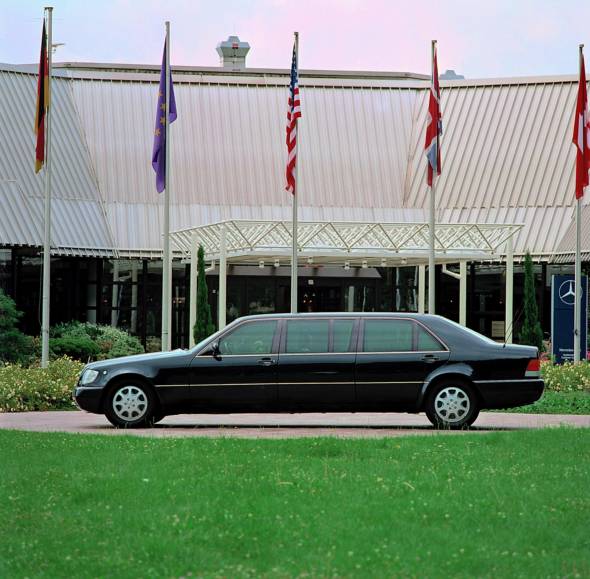
From May 1995 the PARKTRONIC ultrasonic parking assist was also available as an optional extra.
Its electronic control unit computed the distance to an obstacle with the help of ultrasonic signals reflected by the obstacle.
Transmitters and receivers of the ultrasonic signals were combined in sensors integrated into front and rear bumpers, without diminishing in any way the protective function of the bumpers.
PARKTRONIC was fitted as standard equipment to the V12 models from 1995 onwards. At the same time, the now superfluous guide rods in the rear fenders were discontinued in all S-Class Saloons.
Improved engines
The refinements introduced in March 1994 chiefly concerned design, but in September 1995 several technical improvements took effect in the eight- and twelve-cylinder models.
A completely new five-speed automatic transmission with torque converter lockup clutch, already in use since May 1995 in the S 600 Coupé, now took the place of the hydraulically controlled four-speed transmission also in the Saloon models.
The heart of this technical marvel was an electronic transmission control unit, which adapted gear-shifting rapidly and automatically to any given driving situation and which continuously exchanged data with the electronic engine management system.

Apart from these pioneering innovations, the new automatic transmission was also much more compact and lighter than comparable five-speed transmissions.
The engines were updated once more to cut fuel consumption and pollutant emissions further.
The two V8 engines got a modified crankshaft, optimised valve timing, lighter pistons, dedicated ignition coils for each cylinder, as well as an improved electronic engine management system, the Motronic ME 1.0, incorporating a hot-film air flow sensor in place of the previous hot-wire air mass sensor.
The design changes to the V12 engine were less extensive and merely concerned the ignition coil arrangement and the electronic engine management.

As a result of the various modifications to the engine and the use of the new automatic transmission, the fuel consumption of the V8 and V12 models could be cut by seven percent on average without any loss in output, and pollutant emissions by more than 40 percent.
Also from September 1995 also saw the introduction of the Electronic Stability Program ESP® as an option for all S-Class models with eight-cylinder engines, a system that helped the driver to correct driving errors by automatically counteracting momentary instability by sensor-controlled brake intervention, thus contributing to active safety. ESP® was introduced as standard equipment in both twelve-cylinder models.
To begin with it was available as an option with the S 420 and S 500. Then from December 1996 on, ESP® was available with all models when ordered with automatic transmission.

In addition to the described model refinement package, which was presented at the International Motor Show in Frankfurt/Main, a new variant of the S-Class debuted in September 1995: the S 600 long-wheelbase Pullman, developed as a new state limousine with special protection technology, continued a longstanding tradition at Mercedes-Benz.
The specially made vehicle measured 6213 millimetres from nose to tail and was exactly one metre longer than an S 600 with long wheelbase.
The extended length benefited the rear-seat passengers, who occupied comfortable vis-à-vis seats and could separate their rear compartment from the driver’s area by means of a glass partition.
The Pullman Saloon of the 140 series was also available without special protection as S 500 and S 600 models; the first units of both variants were produced in August 1996.

In line with tradition, the normal-length five-seater Saloons of the S-Class were also offered in special protection versions – with a choice of 5.0-liter V8 or 6.0-liter V12 engine.
Production of both special protection models began in February 1992, one year after standard production of the 140 series commenced.
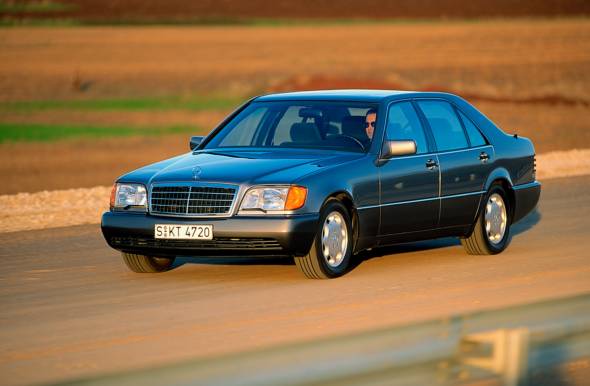
Further upgrading
In June 1996 the S-Class was upgraded once more. Now the new five-speed automatic transmission with torque converter lockup clutch and electronic transmission control was also available for the six-cylinder models – in the S 280 as an optional extra, in all other models as standard equipment.
Simultaneously the acceleration skid control ASR was included as basic equipment in the six-cylinder models.
Other innovations to note included sidebags as standard for driver and front passenger on all models, seat occupancy sensors to operate the front passenger airbags, an “intelligent” rain sensor that controlled the wiper interval in accordance with the volume of spray on the front windshield, and luggage nets in the trunk and front passenger footwell.
Xenon headlamps with a headlamp cleaning system and dynamic headlamp range control were available as an optional extra.
Externally, too, the S-Class saloons had undergone slight modifications when they were presented in June 1996; immediately apparent were the satin-finish detachable body components, now painted in the colour of the car rather than as previously in the contrast colour.

Apart from the described improvements to details, in June 1996 a model change took place in the S-Class: the S 350 Turbodiesel was replaced by the S 300 Turbodiesel.
Unlike its predecessor, the new diesel model had a turbocharged and intercooled engine featuring four valves per cylinder.
The engine output of 130 kW was 20 kW higher; the torque was increased by 20 Newton metres and was now available over a broad engine speed range; pollutant emissions and fuel consumption were appreciably lower as a result of optimised combustion.
The S 300 Turbodiesel was delivered with the electronically controlled five-speed automatic transmission as standard.

From December 1996, S 280 and S 320 models fitted with automatic transmission were also equipped with the Electronic Stability Program ESP®.
At the same time a new innovation had its world premiere as an additional active safety feature – Brake Assist BAS, which was fitted as standard in all models of the 129 and 140 series from December 1996.
Brake Assist (BAS) was able to recognize emergency braking situations and if required to boost brake power to a maximum more quickly than was previously the case, thus shortening stopping distances considerably.

A Landaulet for the Pope
In March 1997 another variant of the 140 series was completed: the S 500 long-wheelbase Landaulet, custom-built for Pope John Paul II.
The Landaulet soft-top was operated electrohydraulically to afford a clear view of the Holy Father seated on his centrally arranged thronal seat.
It was also equipped with folding seats for two attendants.
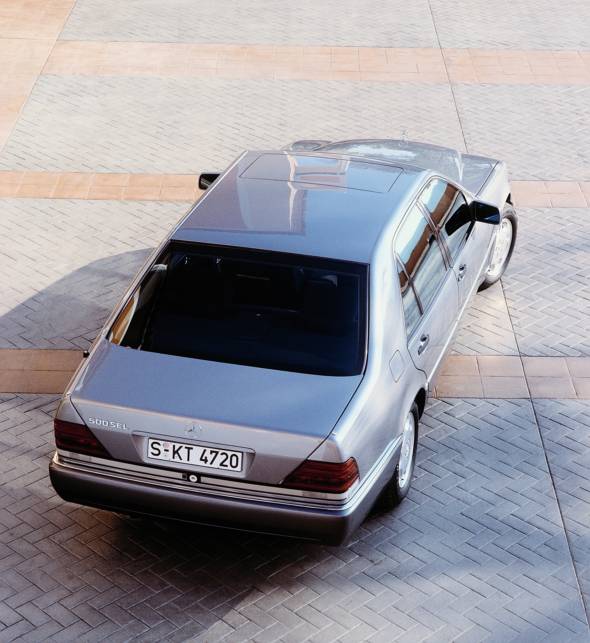
At the Paris Motor Show in September 1998, the public was introduced to six S-Class saloons from the 220 series, which now succeeded the 140 series after a period of seven and a half years.
Series production of the 140 models at the Sindelfingen plant was stopped at this point, and only the armoured versions and the Pullman saloons continued to be built.
By the year 2000, a total of 406,718 140 series saloons had been produced in all variants, of which 28,101 units featured diesel engines.

At the start of its career and particularly in Germany, the largest ever S-Class did not have an easy time – despite the car’s undeniable qualities.
A valedictory appeared in the Frankfurter Allgemeine Zeitung of August 25, 1998 under the headline: “The end of the good patriarch. Sentimental farewell: The S-Class was always better than its reputation.

” This obituary written by Wolfgang Peters included the lines: “…No other car offered such ride comfort and suspension, and no other car in this size category could be driven in such safety and with such agility at the same time.
The S-Class was a giant that had been taught to dance on the points of its toes. […] The new S-Class promises to be lithe and lissom: Some of us are missing the bigger fellow already.”
The 140 series in the press
Auto, Motor und Sport, Germany, issue 7/1991, on the Mercedes-Benz 600 SEL: “With dimensions such as these, there is little to be said about the interior: The sense of space is almost wasteful, even more so in the rear than in the front, since the opulent height in the rear is particularly apt for giving the impression of riding in a mobile living room. … It would not be wrong here to describe this as the world’s finest car – any less would be to do Mercedes an injustice.”
Auto, Motor und Sport, Germany, issue 12/1991, on the Mercedes-Benz 300 SE: “The size and weight of the new S-Class have become almost a political issue.
But in truth, on driving these factors are less noticeable than one might expect. On the contrary, it is surprising how light and easy this mighty automobile is to drive even along narrow and winding country roads.”
Road & Track, USA, December 1991, on the Mercedes-Benz 500 SEL: “At a 70-mph cruise, the 500 SEL has the honor of being the quietest car we have ever tested – a mere 64 dBA.
Helping in the serenity department is double-pane side glass, with dehumidified air sealed between the panes.
It’s said to prevent fogging as well as absorb noise, and no, Mercedes assures us, it isn’t bulletproof, a question some ask when they see its thickness.”
mot, Germany, issue 13/1991, on the Mercedes-Benz 400 SEL: “With the new S-Class Mercedes once again demonstrates its claim to have invented the automobile and to build the world’s best car.
When applied to the 400 SEL, one is forced to admit the claim is justified.”
Production figures for the S-Class Saloons of the Mercedes-Benz 140 series (1991 to 1998)
| Models | Internal designation | Production period: preproduction to end | Number of units |
| 300 SD/S 350 Turbodiesel | W 140 D 35 A | 1990 – 1996 | 20,518 |
| S 300 Turbodiesel | W 140 D 30 LA | 1995 – 1998 | 7583 |
| 300 SE 2.8/S 280 | W 140 E 28 | 1992 – 1998 | 22,784 |
| 300 SE/S 320 | W 140 E 32 | 1990 – 1998 | 98,095 |
| 300 SEL/S 320 long-wheelbase | V 140 E 32 | 1990 – 1998 | 85,346 |
| 400 SE/S 420 | W 140 E 42 | 1990 – 1998 | 14,277 |
| 400 SEL/S 420 long-wheelbase | V 140 E 42 | 1990 – 1998 | 35,191 |
| 500 SE/S 500 | W 140 E 50 | 1990 – 1998 | 21,942 |
| 500 SEL/S 500 long-wheelbase | V 140 E 50 | 1990 – 2000 | 65,065 |
| 600 SE/S 600 | W 140 E 60 | 1990 – 1998 | 3399 |
| 600 SEL/S 600 long-wheelbase | V 140 E 60 | 1990 – 2000 | 32,517 |
| Total | 406,717 |

